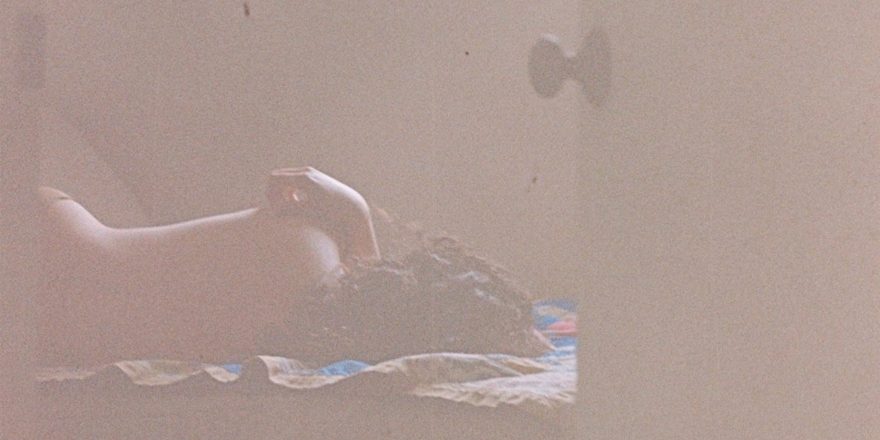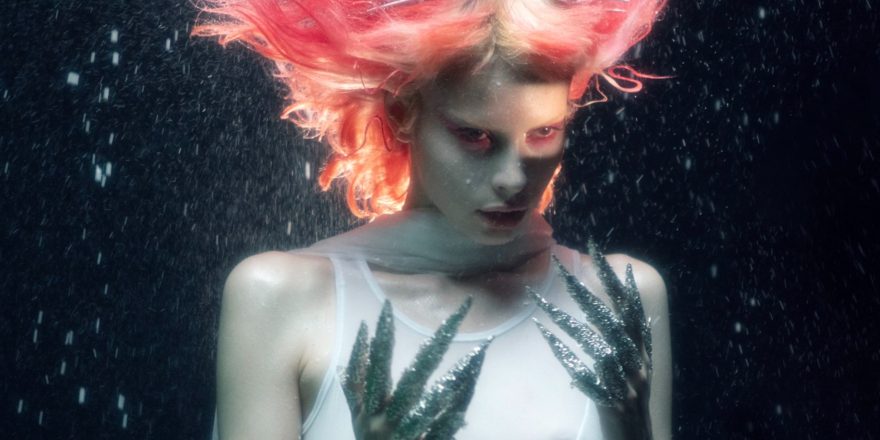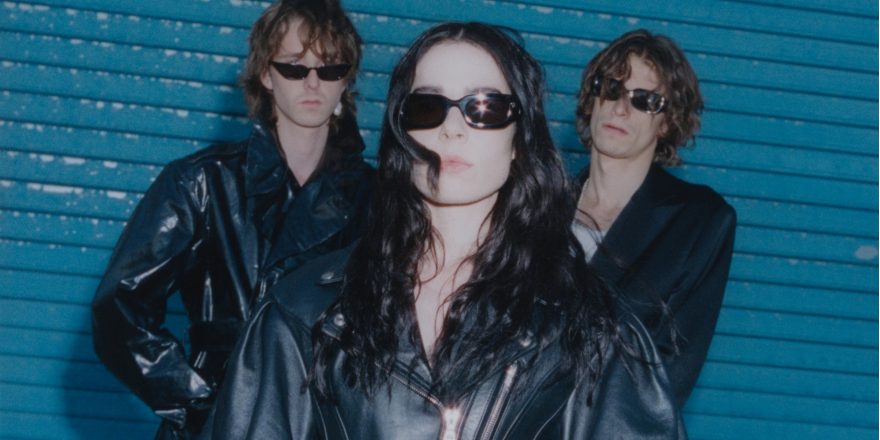The final stop of my first tour finds me braving Connecticut winter in the college town of my favorite ex-boyfriend. It’s the first time I’ve been back since our split, and it’s for the least glamorous of the shows on my little East Coast run. We’re friends now, which explains why he’s in the front row, singing along to the songs the others in this college bar couldn’t be bothered to pretend to care about. My boots stick to the floor of the stage, to the beer and the sweat. I probably would have preferred that he see me at a venue with my name on the green room door, but what can you do? I make a pact with myself not to cry until I finish the set and put myself in a car home.
At 19, I, somewhat obstinately, wrote his name into what would become my song “Visions.” I began writing the lyrics in my college dorm while we were still together, finished them in the immediate and catastrophic aftermath, and released it sometime after our reconciliation. It was debated hotly on the previous tour stops whether I would have the balls to perform the shameless name drop or would awkwardly switch it out for a more toothless “baby.” Ultimately, I welcome the sensation of his friends’ eyes boring into me when I croon his name into the microphone: “David wakes up early just to call my name.” The line is kind; the rest of the song is less so. But it’s certainly honest. He left me in March, two weeks after I fled New York, college, and inpatient therapy. My mental illness had been a point of contention between us, and when I play that song live, I feel my body flung back into the sadness of that season of my life. He hated me for my sadness in equal measure to how I loved it, nurtured it, let it flood my life and my work.
We are all, I’m sure, familiar with the notion of the Sad Girl Singer-Songwriter. It’s sort of an updated take on the mythologized Manic Pixie Dream Girl, mapping the quirked-up ethos of Zooey Deschanel movies onto female folk singers with acoustic guitars. Cult favorites like Ethel Cain and mainstream darlings like Phoebe Bridgers are often referred to as such, heralded as the apex of artistic vulnerability and the voices of an entire generation of women. It’s a far cry from the scene of the early 2010s, when Lana Del Rey’s debut album Born to Die was slaughtered by critics for its melancholy. It’s a brave new world, and the Sad Girl is king.
Back in 2014, when sad music (and maybe even sadness itself) was still subversive, Audrey Wollen made waves with her “Sad Girl Theory,” in which she argued that “the internalized suffering women experience should be categorized as an act of protest” (i-D, 2014).
“I think it’s really important to recognize and foster an alternative to the hyper-positive demands of contemporary feminism right now. We’ve really fixated on loving ourselves — there’s this ethos of excess and approval, making it cool and fun to be a girl.”
She insisted upon a more honest reflection of what she believed to be the ethos of womanhood, which is rife with suffering. By forgoing a forced smile, Wollen didn’t shy away from making men uncomfortable with her frank discussion of misogyny. “Sad girl music” was protest music.
Flash forward almost a decade, and the landscape is nearly unrecognizable. There’s an editorial playlist created and curated by Spotify entitled the “sad girl starter pack,” which has garnered over a million saves. It has long-featured the caption, “Sapphic songs that define your music taste as ‘yearning,’” despite the fact that only recently has it begun to adhere to the “sapphic” requirement. (It wasn’t long ago that songs by Arctic Monkeys and The 1975 were staples of the playlist.) But the trend is clear: sadness is chic, and beautiful women are just as in style as ever. Now that the two have come together to form “Sad Girl Indie,” the definitive genre of Gen Z, everyone is clamoring toward the bandwagon.
The initiation to this in-crowd is held, of course, on TikTok. Two years prior to my first tour, a few blocks away from that eventual last stop and hand-in-hand with my then-boyfriend, a friend introduced me as a “TikTok artist” to the bands sharing the bill for a college radio show. I winced, probably visibly. When I was 18, I had the good fortune of achieving some mainstream success via the internet, my old friend and adversary. In January of 2021, I delicately balanced my phone against a stack of books and recorded a brief clip of a song I had just written. By the time I woke up the next morning, the clip had amassed hundreds of thousands of views. Many of my musician friends and peers have similar stories. These events were a symptom of the massive shift underway within the music industry. TikTok was accumulating power by the minute. As the boy band era of the early 2010s drew to a definitive close, teenage girls with acoustic guitars threw new kindling on the fire in the form of earnest and genuine songwriting. A few of us were lucky to get in at the very beginning, when mumbling a demo into your iPhone really was #raw and #unfiltered. But it was over before it began, and under the guise of democratizing the industry, the algorithm snatched the purse strings from major labels and remade the arena into one of 15-second clips with blocks of text on the screen, forcing the video to loop while the viewer hears the same chorus over and over again. It became equally corporate, but we all had the pleasure of participating in the cookie-cutter promotional grind.
Recently, I spoke to Eliza McLamb, a songwriting peer and friend, about this very phenomenon for her Substack essay “The Algorithm Killed the Radio Star.” “It’s just you and your imperfect, undone charm against the world, and when even that schtick gets taken over and bastardized by the corporate powers that be, things can seem hopeless,” writes McLamb. “At a certain point, artists realized that if they were going to stay relevant on TikTok, they had to play by TikTok’s rules.” These days, I cringe at the memory of captioning my viral video “for art school dropouts + sexy bitches who consistently disappoint their mothers,” but this is just one of the ways I played by TikTok’s rules — or perhaps, less generously, how I helped to write them.
At the time, I probably would have called myself a “sad girl indie artist” with pride. I was, and am, unflinchingly ambitious, and here was an instant-gratification near-guarantee at an audience and an identity in one fell swoop, something most people spend their whole careers searching for. The best part was, it didn’t even feel contrived! I was, and am, a very emotional girl! I’m on a very high dose of Zoloft! I have a complicated relationship with my father! The validation not only of my work, but of me, was a high I had been chasing my whole life, a nigh-universal goal.
But as the corporate infiltration of our sacred music spaces began, the delicate balancing act that allowed me to be myself crumbled. Now, my peers and I felt compelled to recreate those moments of emotional vulnerability to remain relevant. To feed the hunger of the masses for some level of intertextuality to your songs, making a fun video explaining the trauma that inspired your lyrics becomes an obvious next step. After all, “I tried to kill myself and I wrote a song about it” is far more digestible than parsing through lyrical themes.
While the commodification of women’s suffering is anything but new, what is novel is the sheer volume of it. With an average of 49,000 new songs being uploaded to Spotify every single day and God only knows how many “sad girl indie” TikToks, there must be a more rigorous rubric to separate “good” from “great” — or, more accurately, “unmemorable” from “memorable.” Without a quantitative or qualitative measurement of what makes a “good song,” what separates the former from the latter is who is able to bare the most of themselves, to put their darkest moments on display. When the artist hands over the meaning of the song in a pithy caption tied with a bow, making emotional connection a split-second game rather than a hard-earned prize, sadness in music becomes a kind of currency that once belonged exclusively to a catchy hook or an earworm chorus. In our movement away from what McLamb calls “celebrity-as-untouchable-idol to celebrity-as-girl-just-like-me,” the listener is promised not only a song that encapsulates their experiences but a figure with whom to identify. What happens when that figure, that “brand,” is suffering? Extrapolate further, and it isn’t hard to imagine a world where young women foster their own sadness in order to have something to write about. I would know; I’ve done it.
This phenomenon has little to do with Audrey Wollen or Sad Girl Theory. It lacks the teeth cut by Wollen’s struggle against the mainstream but still insists upon its subversiveness. This new landscape is not exploiting the suffering of young women for clicks; it’s uplifting their voices. It’s not financially incentivizing those young women to be complicit in their own exploitation, or even to do the heavy lifting themselves; it’s returning power to the people to tell their own stories. Like much of 21st century feminism, the patriarchy has watered down and commodified what were once radical acts into small plates of easily-accessible ideas. The siren song of Spotify’s curated playlists, paired with the black hole that is the TikTok algorithm, incentivizes young female songwriters to sensationalize their experiences for a better soundbite. What’s rewarded is not protest music. It’s the repeated realization of young women’s buying power in the entertainment market and a tepid repackaging of what was once powerful and subversive.
“Visions” would come out a few weeks after the tour, meaning that anyone, including my favorite ex’s friends, family, or other lovers, could listen to me sing his name. In the weeks leading up to releasing any music, I find myself returning to an interview with poet and 2010s Tumblr messiah Richard Siken. It’s one that grounds me as I feel around in the dark for some kind of security while preparing to bare my soul to the world. The conversation with Tin House, entitled “The Doubling of the Self,” is a meditation on his poetry and his identity —which he notably regards as two separate things. He writes,
Additionally, readers began to ask me if the poems were “true,” by which they meant, “Did they really happen?” which seemed both beside the point and also intrusive. I realized that if they thought poems were biographically accurate, then they could walk away, knowing I was just a sad little man. If, however, the poems were crafted and framed with intent, then they would be confronted with a piece of art. No longer able to simply pity me, these readers would have to take ownership of their feelings and reactions.
Rather than giving a listener a framework for dismissal, as Siken experiences, sadness is the glue that holds the new indie scene together. Putting your traumatic experiences on display makes you a leader, a prophet for anyone who has ever experienced anything similar. And isn’t that messianic experience what we’re all in search of? Isn’t that why everyone gets into this business? Isn’t it?
Maybe in another world, some parallel universe, I’m finding wild success as a singer/influencer/TikTok trendsetter. Maybe I’m lip syncing to my songs about suicide. Maybe I’m taking pictures of myself when I cry and wondering if, when money gets tight, I might be able to sell them. 






